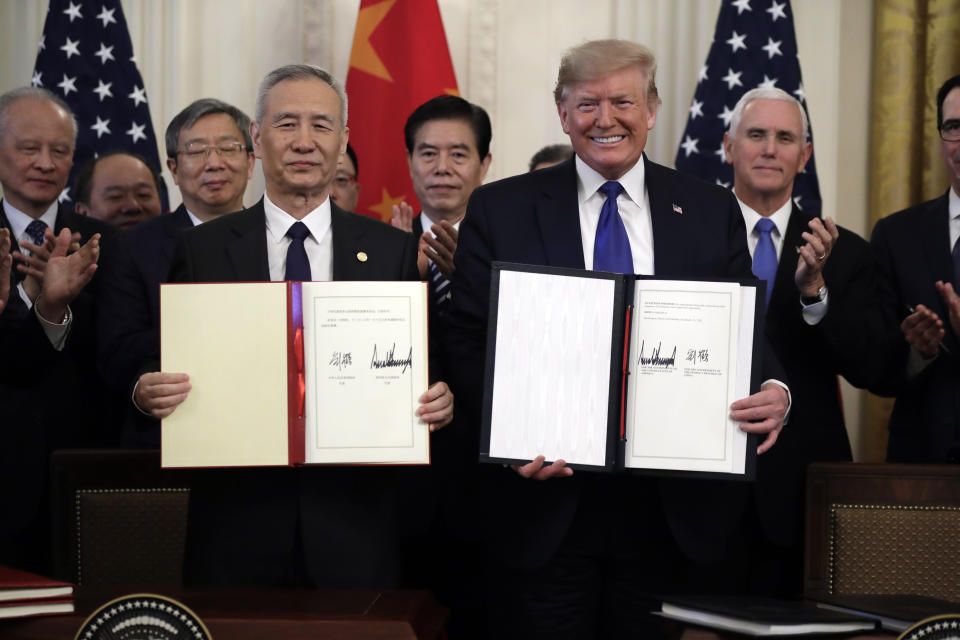Trump’s China deal will hurt more than it helps
It could have been worse. That’s about the best trade experts have to say about the “phase one” trade deal President Trump inked with China on Jan. 15.
Under the so-called deal, China has pledged to buy about $100 billion in additional American exports per year, on top of what it was already purchasing before the trade dispute erupted in 2018. If that happens, it would be a big boost for U.S. exporters.
But there are many warning signs that neither side will ever uphold its side of the bargain. Trump has exaggerated and lied about progress on the deal for months, and the phase one deal may be more dissembling. Plus, the deal leaves in place tariffs on U.S. imports that raise costs for American businesses and consumers.
“While the deal is a step in the right direction, further tariff rollbacks should not be expected until after the elections, and broken promises could lead to tariffs snapping back in the coming months,” forecasting firm Oxford Economics advised clients. “Elevated policy uncertainty will keep businesses on the sidelines until further clarity emerges on the long-term bilateral relationship.”
Trump has imposed tariffs on the majority of Chinese imports to the United States, and most of those tariffs will remain in place. The average tariff rate on Chinese imports has risen from 3% in 2017 to 19% now. That’s where it will stay.
Trump has repeatedly said China is bearing the cost of the tariffs, which is incorrect. In more than half a dozen studies, economists have found American businesses and consumers are paying the tariffs and the net effect on the U.S. economy is negative.
“All of the studies that considered the impacts of tariffs on imported goods prices concluded that the tariff costs imposed by the U.S. were nearly 100% passed on in the form of higher costs and were absorbed in part by importers and in part by U.S. consumers,” Robert Eisenbeis, vice chairman of Cumberland Advisors, explained to clients recently. “Some domestic producers did benefit from the tariff protections, but those gains appear to have been offset by losses to other producers.”

One study, by the New York Federal Reserve, estimates that Trump’s tariffs have cost the average U.S. household $414 in higher costs and depressed economic activity. Another study, by the Tax Foundation, argues that the Trump tariffs will cost the economy 199,000 jobs. In 2018, Trump imposed tariffs on imported washing machines that have raised the cost of those appliances by 12%, or $86 per unit.
Is Trump exaggerating?
Trump and his defenders argue that his trade war has caused no recession, as some critics predicted, with the unemployment rate still at a historically low 3.5%. All that’s true. But the economy is growing at only around 2%, far short of Trump’s 3% goal. The manufacturing sector, where importers are now paying higher prices for imported components, is under stress and may be contracting. Business spending has stalled. Farm bankruptcies are rising, with American farmers hurt by China’s retaliatory measures against U.S. farm imports.
If China really does ramp up purchases of U.S. food products, farmers would rejoice. But keep the champagne corked. “In reality, the scale of the required increases in Chinese purchases means that it is never going to happen,” research firm Capital Economics believes.
For China to buy as much new U.S. farm products as it seems to be promising, it would have to sharply curtail agricultural purchases from other countries, such as Brazil and Russia. “This is a potential area of conflict with the rest of the world,” economist Chad Bown of the Peterson Institute for International Economics told reporters after the Jan. 15 trade deal signing. “If they’re not opening up markets overall, and they don’t start buying from everyone else, that’s a big concern to the international community.” Chinese trade partners who feel cheated would have a solid case if they complained to the World Trade Organization.
Could Trump and his team be exaggerating what the phase-one thingy is likely to accomplish? Likely and perhaps certain. Trump has lied repeatedly about progress in the trade talks and the consequences of the trade dispute. His favorite lie is the claim about China bearing the cost of his tariffs, which he has spun well over 100 times. He also likens the U.S. trade deficit with China to theft and seems to think his tariffs have sent China back to medieval times. So when he says he has notched a great deal with China, discount that: It’s more like the best deal this month.
Of course, it depends what you compare the deal to, and markets clearly favor the phase-one outcome over endless tariffs. “It’s better than escalation,” says Bown. “Was this all worth it? That is a very different question. I’m not willing to stipulate we’ll be better off under this deal than if we had taken a different approach.”
Rick Newman is the author of four books, including “Rebounders: How Winners Pivot from Setback to Success.” Follow him on Twitter: @rickjnewman. Confidential tip line: [email protected]. Encrypted communication available. Click here to get Rick’s stories by email.
Read more:
Read the latest financial and business news from Yahoo Finance
Follow Yahoo Finance on Twitter, Facebook, Instagram, Flipboard, SmartNews, LinkedIn, YouTube, and reddit.
